Guide to writing a dissertation on the “Arab Spring”
by Enrico Galoppini
 In the field of the graduation thesis assigned in some faculties of humanities, there has become increasingly common the choice, by the candidates, of the research centered on the so-called “Arab uprisings” and the whole series of social and political upheavals that have been attributed (by the global media) the definition of the “Arab Spring”.
In the field of the graduation thesis assigned in some faculties of humanities, there has become increasingly common the choice, by the candidates, of the research centered on the so-called “Arab uprisings” and the whole series of social and political upheavals that have been attributed (by the global media) the definition of the “Arab Spring”.
Except that many, too many undergraduates surf the net randomly, moreover not supported by their teachers with the necessary clarity of views. So, there is a real risk that these thesis are resolved in a diligent chronicle of the facts (or rather, of some “selected” facts), topped by the pleasant considerations about “freedom” and “human rights”.
That is how I felt the need to propose, for the benefit of these graduates, an intervention in which I emphasize the importance of geopolitical analysis and analytical tools of the geopolitics itself, as well as the indispensability of an overview of the problems of “international politics”, constantly bearing in mind the guidelines of the recent “modern history”.
It is a story to be read in a meta-historical perspective, or from the point of view of a ‘thin’ or ‘occult’ dimension that inevitably creeps in human affairs.
Let us begin by asking some general questions that should never be forgotten in a thesis of this kind.
First, it is dangerous to limit the analysis to a single country. And not even to only “Arab-Islamic world”.
If, indeed, the upheavals to which media have attributed the above optimistic denomination may have endogenous motivations which should not be neglected, it is impossible not to consider the overall picture of the balance of power in the world. Within which some countries more than others (Egypt, for example), as well as some areas characterized by their cohesion, as the Maghreb region or the Syrian-Palestinian, are of particular strategic importance.
In short, to get on top of something and not get lost in the most insignificant details, we must first resort to the geopolitical analysis, which considers only in the second order the socio-economic and “ideological” (in the broad sense) factors, rather overrated by the same media and by most of the “authoritative” analysis of those that have found an ample space to meditate on.
In summary, this is a matter – in this as in other case studies – of a struggle between the Great Powers aimed to hold the control of the leadership of the respective states of the region centered in the Mediterranean and at the crossroads of Europe, Africa and Asia. Leaderships which, once having come to power, having their “ideology” (including religious) on the basis of which they seek to govern the companies set up by them. Not to mention, then, the availability to the perpetual indebtedness through “structural reforms” imposed by external sponsors, the provision of its territory for military bases, the exploitation of raw materials and local labor etc…
In short, it is good to join the range of ideas, that here as elsewhere, we must consider everything within the framework of a kind of chess game among few players who can really be said “to make policy” on a global level. A “global” policy, therefore, actualized to different times depending on the objective of this or that player.
Now, since the ultimate goal pursued by the “Westerners” is, quite evidently, the World Government (according to a socially omnipervasive scale of values, a precise economic and financial system based on the interest bearing loan and “debt money”, etc.), it goes without saying that even this “Arab Spring” – like the “color revolutions” (Serbia, Ukraine, Georgia, Central Asia etc.) – is used to operate a change of leadership, and alliances, but also to encourage political and social changes within countries affected by these upheavals.
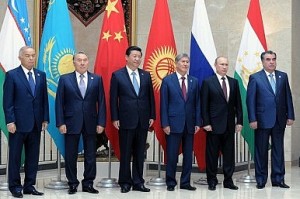 On the other side, in opposition to the West, there are Russia and China (not necessarily getting along well and agreeing on everything), which do not pursue in any way the final strategic goal of world domination and to conform it to their own scale of values. But there is one thing they care about without doubt: the control of a “safety belt”, which goes for Russia from Eastern Europe to the Pacific, through the Caucasus and Central Asia. But that is the minimal “belt” as it were, because for its own safety Russia (never mind for now China) must be careful to what happens both in Turkey and in the Near East.
On the other side, in opposition to the West, there are Russia and China (not necessarily getting along well and agreeing on everything), which do not pursue in any way the final strategic goal of world domination and to conform it to their own scale of values. But there is one thing they care about without doubt: the control of a “safety belt”, which goes for Russia from Eastern Europe to the Pacific, through the Caucasus and Central Asia. But that is the minimal “belt” as it were, because for its own safety Russia (never mind for now China) must be careful to what happens both in Turkey and in the Near East.
In this specific region, Syria is for decades a traditional ally of Moscow, with communism or without communism, that proves that the strategic attitude does not change with the change of the official ideology.
And, above all, there has not changed the Western hostility toward Russia, with which it has proved conclusively that anticommunism – beyond the different “ideologies” of either of global players – was a masque useful for various purposes (for example, the military coups in Latin America).
In this framework, which inevitably can only be global because now the international policy rolls three hundred and sixty degrees, the importance of Egypt cannot escape any of the contenders. The issue was very clear during Nasser’s rule and the subsequent “breakthrough” of Sadat: from alliance with Moscow to the alliance with Washington, with an annexed “peace” with Israel.
The situation has not changed today. With China that goes spreading like wildfire its commercial influence. This is to emphasize that first of all one must to look at the geopolitics, and then at the rest (internal political and economic situation and all that on average thrills the consumers of the chronicles of newspapers, like “human rights”, the “conditions of women”, etc.). Otherwise you can never give a logical explanation to the question why in front of similar situations the results are completely different: revolt and Western intervention in Libya and Syria; media blackout on the repression of dissents in the Gulf countries).
The argument, as you can well understand, is so vast that, in my opinion, before starting to write a thesis on the so-called “Arab Spring” centered on a single country or the whole “Arab-Islamic world”, one should:
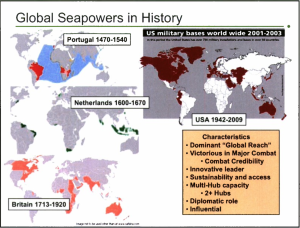 – Acquire the fundamentals of Geopolitics and, specifically, to identify the guidelines followed by the “powers of the sea” (United Kingdom and United States) and those “of the earth” (Russia, especially, and China, partially). Which, respectively, follow different purposes or different models of civilization, and, based on that, they adopt different tactics and tools.
– Acquire the fundamentals of Geopolitics and, specifically, to identify the guidelines followed by the “powers of the sea” (United Kingdom and United States) and those “of the earth” (Russia, especially, and China, partially). Which, respectively, follow different purposes or different models of civilization, and, based on that, they adopt different tactics and tools.
– Have a historical and geopolitical summary of the last two or three centuries, starting with the birth of the United States and their “messianism”, the emergence of the “Islamic modernism” (Wahhabism, in particular), the end of the empires (Russian, German, Austro-Hungarian Empire and the Ottoman Empire) and the emergence of nation-states in the Middle East, with all their consequences on a level of permanent conflict in the region and beyond (just think how much Italy – Mediterranean nation par excellence – is involved in all these), especially since the birth of the Zionist project and the subsequent building of its political-territorial-military outpost.
– Read then the result of the Second World War not with ideological glasses, but with those of geopolitics (occupation, for the first time, by the US, of a part of Europe, or rather the extreme western part of Eurasia, without which there would not have been possible the subsequent “wars of NATO”, just as an example).
– That said, even the famous “September 11” loses that aura of ‘Big Bang of the twenty-first century’, rather than being inscribed in a historical perspective of the long course that must simultaneously consider many factors.
– Establish the irreconcilable differences between traditional Islam (understood as an attitude toward the sacred and the divine), which is the result of a history of fourteen centuries of doctrinal elaboration, devotion, of the saints… and that of the “modernists” of all kinds whose forerunners, in modern times, were the Wahhabis and the allied Saudi dynasty, in their turn being allies of the “Westerners”.
– Last, but not the least, outline why and how the symbiotic relationship between the United States and Israel has developed, identifying the short- and long-term strategic alliance that define “strategic” is reductive.
Only after the analytical and synthetic examination of these six points, to clarify well the background before proceeding in any research work focused on a “case study”, one can move on to a discussion of what has happened in the Arab-Islamic world during the last three years, without losing sight of the development of so-called “Middle East issue”, of which the “Palestinian” is nothing but its reproduction on a smaller scale. To bring an example: you cannot deal with the topic of the “Arab Spring” if you do not understand well the meaning of the Gulf War of 1991… Just to not forget that these facts that we get on the agenda have roots in past, both recent and more remote. A past that can be comprehended only if you hold together all the pieces of the mosaic.
The greatest mistake not to commit, then, is to approach the topic with the same attitude of the authors of the instant books, who by their misinformation or simple-mindedness (or worse), churn out books that leave the time they find (and, unfortunately, space in university classrooms). Moreover, their authors seem completely dazzled by the “wind of freedom” or “change” that a rhetoric by easy grip on the Western audience is blowing from one end to another of the Arab-Islamic ecumene.
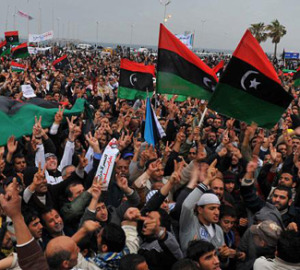 I understand that this sentimental approach can inspire generalizing public in search of excitement, but a serious analyst (and the same applies to a graduate student) can not fall into these hallucinations, although 99% of the “information” more easily available would confirm him in this impression. Namely, that of being in the presence of a historical page of “human progress”, the dawn of a “new world” and here we go fantasizing.
I understand that this sentimental approach can inspire generalizing public in search of excitement, but a serious analyst (and the same applies to a graduate student) can not fall into these hallucinations, although 99% of the “information” more easily available would confirm him in this impression. Namely, that of being in the presence of a historical page of “human progress”, the dawn of a “new world” and here we go fantasizing.
What to say to them, after the ‘masterpiece’ perpetrated in Libya? In a country where from the material point of view nothing was lacking (so the argument of “misery” fails). Let’s consider instead how Libyans live now (a kind of Somalia) and pull the money from those who have gained from all this story.
Yet, there always appears somebody who objects: “But before there was no freedom”. Good argument: “freedom” (which for the majority now coincides with “do whatever you want”); if then nothing works anymore, the law is replaced with the free will of armed gangs (in addition fanaticized), and however much of incontestably good had been done for the welfare of the population by the late Gaddafi (especially when compared to other Arab and African countries), it is systematically dismantled just to say that there is the “change”!
And that’s not all, because with the compass of geopolitics, which invites us always to identify the common thread that unites every link in the chain to another, you realize that the destruction of the Jamahiriyya arose only after the “uprisings” in Tunisia and Egypt… and after it there broke out the chaos in Mali, with infiltration efforts in Algeria, a country very important from the point of view of energy with which Russia and Italy have excellent relations… the same Algeria already ravaged in the Nineties by an “Arab Spring” ante litteram, which resulted in a scenario that we have seen repeated in Syria. Not to mention the Treaty signed between Libya and Italy just a year before the devastation justified by the usual media cancan, always keeping in mind that the “media” are a weapon in all respects, to the service of the conventional ones, when there is the need for those in control of both.
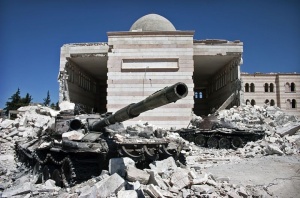 Syria is also a great example to understand “who stays behind whom”. On one side there is the government, supported by Russia and Iran (and China, more on a backseat), on the other there are Westerners: US, Israel, European Union, although in the latter there are different positions (typical Italian, which can not betray its geopolitical Mediterranean vocation solely in favour of Euro-Atlantic interests), and petromonarchies of the Gulf, bearers of the “modernist” Islamic ideology and supporting a diverse galaxy of political and armed movements. This is a very important point to understand: the alliance between the “Islamic modernists” and Westerners, that dates – in a manner least obvious – at least from the war in Afghanistan against the Russians in 1980, but actually began well before because there are deeper dynamics that do not show out to those who view the issues only on the surface.
Syria is also a great example to understand “who stays behind whom”. On one side there is the government, supported by Russia and Iran (and China, more on a backseat), on the other there are Westerners: US, Israel, European Union, although in the latter there are different positions (typical Italian, which can not betray its geopolitical Mediterranean vocation solely in favour of Euro-Atlantic interests), and petromonarchies of the Gulf, bearers of the “modernist” Islamic ideology and supporting a diverse galaxy of political and armed movements. This is a very important point to understand: the alliance between the “Islamic modernists” and Westerners, that dates – in a manner least obvious – at least from the war in Afghanistan against the Russians in 1980, but actually began well before because there are deeper dynamics that do not show out to those who view the issues only on the surface.
With that we return to the “ideologies”, or rather the “world views”, linked to the “obedience” and “affiliations” more or less hidden, that at first I intentionally set aside to focus on the geopolitical analysis.
I mean that the “ideologies” should not be overestimated for the explicit and obvious use that this or that state do of it, while they are to be taken to the utmost account on a so-called “occult” level. That is, nothing is ever as it seems, because there is a dimension of the history and politics that goes much deeper than the party and state denominations, as well as official “schools of thought”. For this reason, when one is unable to find the reasons for the “unexplainable” alliances or incomprehensible “pigeonwings”, in addition to the mere community of interests more or less contingent, one must consider what works “behind the scenes”.
It is therefore essential to identify the “world view”, or rather the model of civilization and the corresponding “human type” encouraged by this or that global player in order to really understand what is its purpose in the long term, beyond the tactical adjustments .
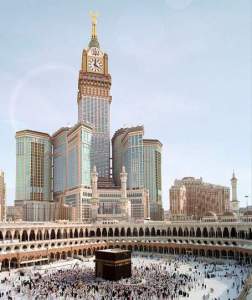 To say it even more explicitly, since each hierarchy is a reflection of the hierarchies which are located on the “invisible” planes, as below so above the human plane, it is essential, in order to really understand the meaning of any historical phenomenon, political and social, to connect elites and leaderships which are its protagonists of “heavenly” or “underworld” influences, of which they are a vehicle having addressed them their own cult.
To say it even more explicitly, since each hierarchy is a reflection of the hierarchies which are located on the “invisible” planes, as below so above the human plane, it is essential, in order to really understand the meaning of any historical phenomenon, political and social, to connect elites and leaderships which are its protagonists of “heavenly” or “underworld” influences, of which they are a vehicle having addressed them their own cult.
With that the circle closes, understanding that if on one hand the geopolitical analysis explains a lot and is the starting point of the survey, at the end you have to make the effort to understand what kind of civilization is pursued by a global player rather than by another.
The man, in short, is the stakes of all, in a perspective that considers the presence and influence of “not human” forces, with which men try to get in touch, literally putting themselves at their service.
I understand that the latter point can seem “cryptic” to someone, and that can not be easily addressed in the frames of a graduation thesis, even considering the space and the time that one can devote to it. Also, approaching it implies a certain disposition both of lecturer and student, so I only plant a seed of doubt offering my availability for further insights, essential, I repeat, for really understanding the “sense of history”, of which the so-called “topicality” is merely a perceptual distortion crafted to give free rein to the media apparatus and superficiality that it induces.
Let meprovide in closing some quick bibliographic and webographic advice.
Let’s start with the books of CeSEM – Eurasia-Mediterranean Study Center (http://www.cese-m.eu/cesem/category/biblioteca/), which published texts on Qatar, Syria, Libya and so on within the framework of “riots “in the subject and which is planning to publish more texts.
Even the magazine on the geopolitical studies “Eurasia” has addressed the issue on several occasions, both in quarterly print filesand on its website (http://www.eurasia-rivista.org/).
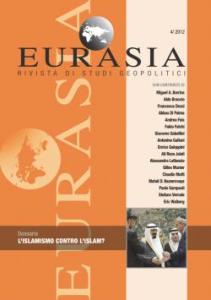 In particular, it devoted an entire issue to Islamism against Islam? (http://www.eurasia-rivista.org/lislamismo-contro-lislam-3/17958/) of which, on the net, you can read the editorial by the director, C. Mutti: http://www.eurasia-rivista.org/lislamismo-contro-lislam/17951.
In particular, it devoted an entire issue to Islamism against Islam? (http://www.eurasia-rivista.org/lislamismo-contro-lislam-3/17958/) of which, on the net, you can read the editorial by the director, C. Mutti: http://www.eurasia-rivista.org/lislamismo-contro-lislam/17951.
Allow me then an autocitation: at the following address you can read my speech on the “Arab uprisings” (http://www.ildiscrimine.com/primavera-araba-dei-tempi/), published April 6, 2011 on a site currently ceased (“European Phoenix”). This is not a “scientific paper”, of course, but an analysis of the whole of the problem, according to my information, according to the way I see and I developed the ability to put together the various pieces of the mosaic.
As you can easily understand, I cannot but recommend the books, magazines or sites critical of the “official version” because the “information” apparatus is seriously unbalanced in the sense pro-uprisings and “springs” (except for a pivot, noted in Italy, both on some TV channels and some national newspapers, since a few months ago, that is when the Muslim Brotherhood have been sidelined in Egypt…).
The first serious book (meaning “argued”) written on this subject – as there were already being published many instant books – was Capire le rivolte arabe [Understanding the Arab uprisings], by D. Scalea and P. Longo. Here I report the reference site of the book: http://rivoltearabe.blogspot.it/. It starts from a far-reaching perspective to frame the particular matter. It does not enter into that “occult” dimension I mentioned earlier, but hardly will be treated in the specific books on the subject.
For those, however, who do not simply satisfy themselves of the keypolitical, economic and social reading, it is should definitely advisable to read a speech, published in due course on the website of “Eurasia”, which summarizes the subversive action of a certain “modernist” Islam: http://www.eurasia-rivista.org/cogit_content/articoli/EEkkAAZlEEGytNtwrs.shtml. An Islam that we see at work in the first row in the “uprisings”, tactically alongside the so-called “bloggers” and champions of “human rights”… and which I have tried to overview in the light of their most recent sallies in this article written for “Africana”: Chi manovra i “modernisti islamici”? [Who maneuvers the “Islamic Modernists”?] (XVII, 2012, pp. 141-148, which is now also possible to read into English: http://www.ildiscrimine.com/who-manoeuvres-the-islamic-modernists-focus-on-libya/).
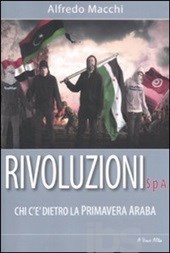 Another reading in my opinion useful forgetting rid of fantastical ideas about the “magnificent and progressive consequences” of the “Arab Spring” is Rivoluzioni S.p.A. [Revolutions LTD], by A. Macchi (review here: http://www.ilfattoquotidiano.it/2012/03/28/alfredo-machine/200498/), which explores the theme of preparation of “revolutionary” humus by the Western “think tanks”. You will immediately understand the link between the “color revolutions” and the “Arab Spring”.
Another reading in my opinion useful forgetting rid of fantastical ideas about the “magnificent and progressive consequences” of the “Arab Spring” is Rivoluzioni S.p.A. [Revolutions LTD], by A. Macchi (review here: http://www.ilfattoquotidiano.it/2012/03/28/alfredo-machine/200498/), which explores the theme of preparation of “revolutionary” humus by the Western “think tanks”. You will immediately understand the link between the “color revolutions” and the “Arab Spring”.
Also, it may be interesting to read a book by the former Socialist minister G. De Michelis: http://www.amazon.it/Mediterraneo-ebollizione-Cause-prospettive-Primavera/dp/8874933126/ref=sr_1_19?ie=UTF8&qid=1390152505&sr=8-19&keywords=primavera+araba. I recommend it just because De Michelis being a politician of so-called “First Republic” and of an Italy less servile towards NATO than the “Second”, it exposes some interesting reflections, furthermore that the publisher Boroli published some texts treating geopolitics.
In English there is Arab Monitor, to which newsletter you can subscribe:
http://www.al-monitor.com/pulse/home.html. Well done and constantly updated with varied insights always well documented and argued.
In French there is the Reseau Voltaire: http://www.voltairenet.org/fr (also has a newsletter), animated by Thierry Meyssan, who probably is the first who has written a book that debunks the “official version” of the events of 11 September 2001. The articles are full of food for thought. This site is also useful to understand the plotting accomplished by “No profit” and the like before the “uprisings”, so that you can feel the pulse of their “spontaneity” (after all, there is “spontaneous” in it). The general trend is pro-Russian and very critical of the “Arab Spring”.
For the rest, typing “Arab Spring” or “Arab uprisings” on the site of a well-stocked on-line book-store (e.g. Hoepli.it), you will easily find many titles, of a doubtful and disparate value, among which I would say that deserves to be read is the book by M. Campanini (it can be found among the results of search; http://www.hoepli.it/cerca/libri.aspx?ty=1&query=primavera+araba&arg=), only because it is a serious scholar, even with his own preferences (as everyone has, after all).
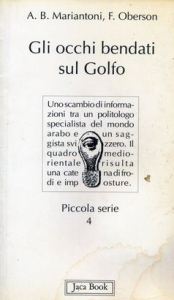 I omitted the specific texts on politics and history of individual Arab countries, like others on the history of the Arab and Islamic world in general, but at the last minute I would highly recommend the reading of a book even now disappeared from the catalog of its publisher (Jaca Book), which at its time had the advantage of literally opening my eyes. It is A.B. Mariantoni, Gli occhi bendati sul Golfo [Blindfolded the Gulf] (1991), which can be found in .pdf format on the site of the author (who unfortunately has died): http://www.abmariantoni.altervista.org/vicinooriente/Occhi_bendati.pdf.
I omitted the specific texts on politics and history of individual Arab countries, like others on the history of the Arab and Islamic world in general, but at the last minute I would highly recommend the reading of a book even now disappeared from the catalog of its publisher (Jaca Book), which at its time had the advantage of literally opening my eyes. It is A.B. Mariantoni, Gli occhi bendati sul Golfo [Blindfolded the Gulf] (1991), which can be found in .pdf format on the site of the author (who unfortunately has died): http://www.abmariantoni.altervista.org/vicinooriente/Occhi_bendati.pdf.
To conclude this intervention, without any pretense of completeness and ordliness, I express the hope of having contributed to provide some news or ideas to reflect on more for the benefit of those who are about to complete a work of graduation thesis which relates to the so-called “Arab Spring”.

 Articolo Precedente
Articolo Precedente Articolo Successivo
Articolo Successivo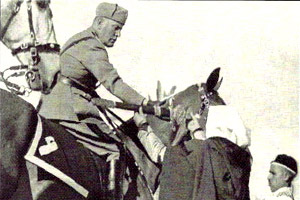 Fascism and Islam
Fascism and Islam 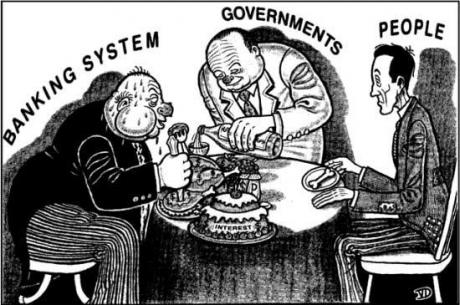 Economic globalization: “Swindlers of the world, unite!”
Economic globalization: “Swindlers of the world, unite!” 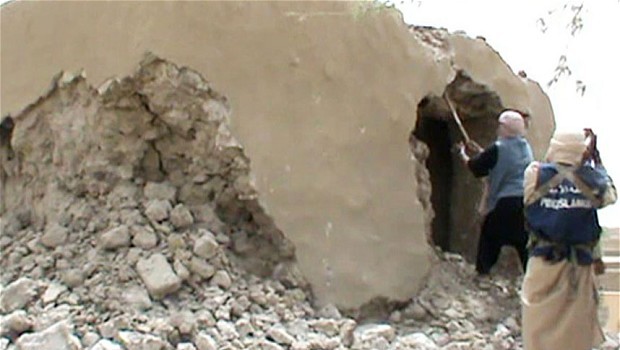 Who Manoeuvres the “Islamic Modernists”? A Focus on Libya
Who Manoeuvres the “Islamic Modernists”? A Focus on Libya 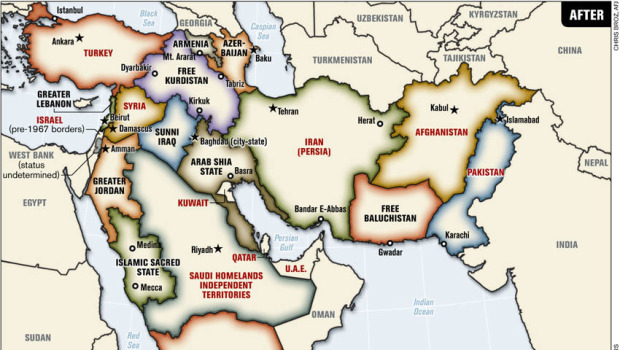 The “Great Middle East” and the anti-Islamic moment of the “clash of civilizations” (the Italian case)*
The “Great Middle East” and the anti-Islamic moment of the “clash of civilizations” (the Italian case)*  The “message” of Paris massacre: “Islam hates us”
The “message” of Paris massacre: “Islam hates us”  Enrica Perucchietti & Gianluca Marletta, The Factory of Manipulation, Arianna Publ., Bologna 2014
Enrica Perucchietti & Gianluca Marletta, The Factory of Manipulation, Arianna Publ., Bologna 2014  Is “free Libya” an appendage of ISIS?
Is “free Libya” an appendage of ISIS? 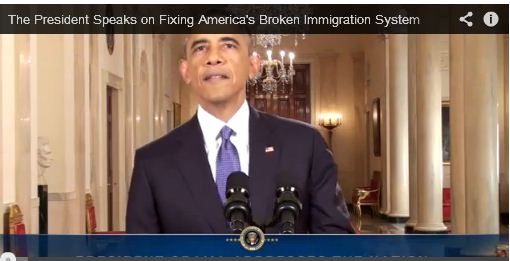 America: but which … “Country of Immigrants”!
America: but which … “Country of Immigrants”!